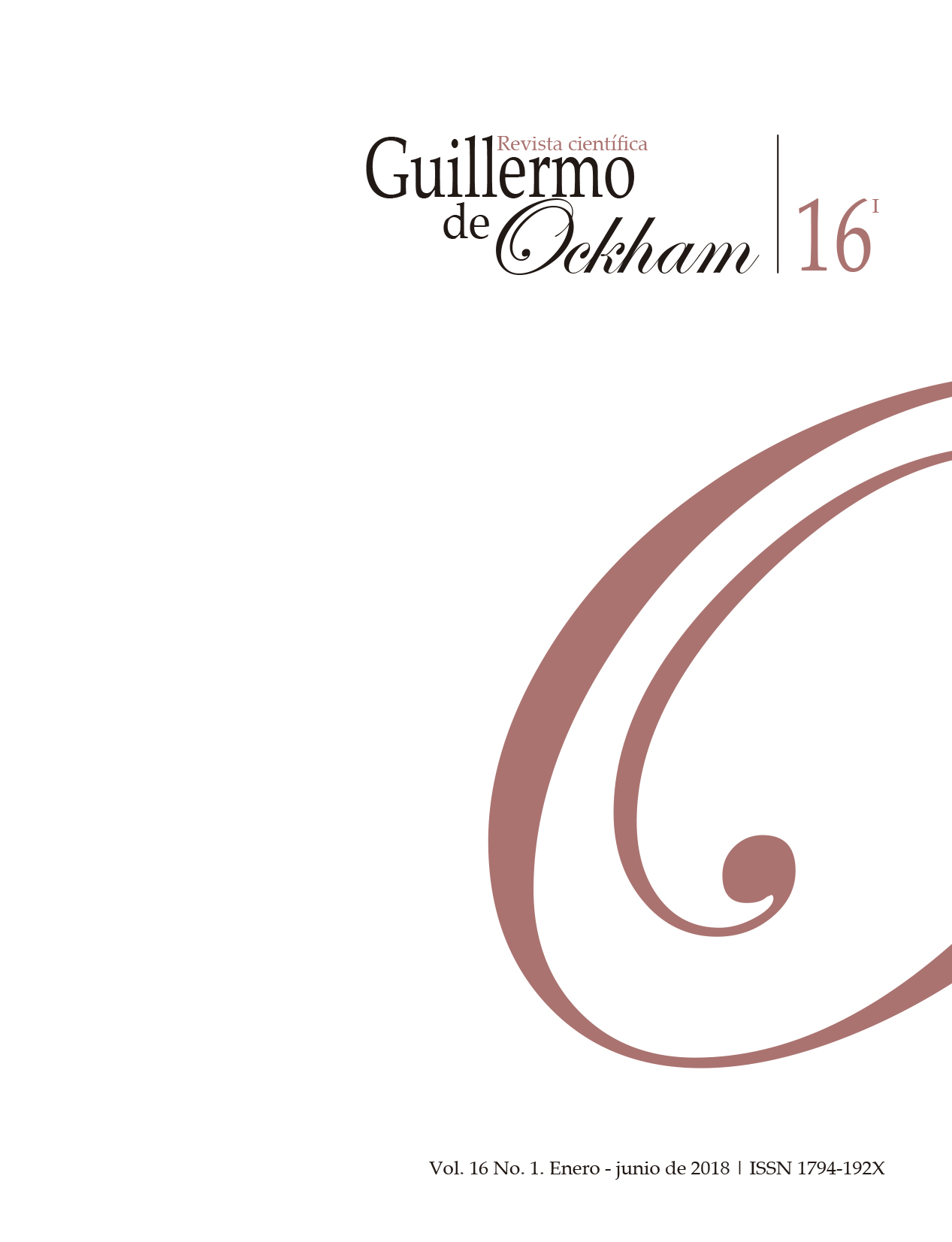The Revista Guillermo de Ockham provides an immediate and open access to its content, based on the principle of offering the public a free access to investigations to provide a global interchange of knowledge.
Unless otherwise established, the contents of this journal has a license with Creative Commons Attribution-NonCommercial-NoDerivatives 4.0 International (CC BY-NC-ND 4.0) http://creativecommons.org/licenses/by-nc-nd/4.0/
- Attribution: You must give appropriate credit, provide a link to the license, and indicate if changes were made. You may do so in any reasonable manner, but not in any way that suggests the licensor endorses you or your use.
- NonCommercial: You may not use the material for commercial purposes.
- NoDerivatives: If you remix, transform, or build upon the material, you may not distribute the modified material.
- No additional restrictions: You may not apply legal terms or technological measures that legally restrict others from doing anything the license permits.
Resumo
The purpose of this study is to meet the motivations and psychological state of the popular runners, differentiating between federated and non-federated, and between men and women. The sample was composed of 473 popular runners, using Motivations of Marathoners Scales (MOMS) and CSAI-2R to evaluate motivation and anxiety. The results indicate that federated runners present higher scores in sense of life and lower scores in self-confidence, achievement of personal goal, self-esteem and recognition search. On the other hand, the men obtained significantly higher scores on physical fitness, social interaction and attraction to the competition, convenience and competition and lower scores on the meaning of life.
Referências
Barrios, R. (2001). Motivación hacia la práctica del ejercicio en corredores cubanos. EFDeportes.com, Revista Digital, http://www.efdeportes.com. Buenos Aires Año 6 - Nº 31. Feb/2001.
Barrios, R. y Cardozo, L. (2002). Motivación para competir en corredores populares cubanos. Disponible en http://www.efdeportes.com/efd47/motiv.htm (visitado el 15 octubre del 2012).
Donzelli,G.J., Dugoni, B.l. y Johnson, J.E. (1990). Competitive State and Competitive Trait Anxiety Differences in Non-Elite Runners / Difference d’anxieté de competition de caractere ou de situation chez des coureurs ne faisant pas partie de l’elite”, Journal of Sport Behavior, 13 (4), 255-266. Disponible en: http://psycnet.apa.org/record/1991-17100-001.
Jaenes, J. C. (2000). Estado emocional y conducta deportiva: Ansiedad competitiva en corredores de maratón. Tesis Doctoral. Universidad de Sevilla, Sevilla.
Jones, G., y Swain, A. (1995). Predisposition to experience debilitative and facilitative anxiety in elite and non-elite performers. The Sport Psychologist, 9, 201 211. Disponible en http://journals.humankinetics.com/tsp-back-issues/tspvolume9issue2june/predispositionstoexperiencedebilitativeandfacilitativeanxietyineliteandnoneliteperformers. DOI: https://doi.org/10.1123/tsp.9.2.201
Llopis, D., y Llopis, R. (2006). Razones para participar en carreras de resistencia. Un estudio con corredores aficionados. Cultura, Ciencia y Deporte, 2(4), 33- 44. Disponible en http://www.redalyc.org/pdf/1630/163017601005.pdf. DOI: http://dx.doi.org/10.12800/ccd.v2i4.168.
Lopez-Gullon, J. M., Torres-Bonete, M. D., Berengui, R., Diaz, A., Martinez Moreno, A., Morales, V. y Garcia-Pallares, J. (2012). Rendimiento físico y psicológico en lucha olímpica: predictores del éxito en lucha femenina. Anales de Psicología, 28(1), 215-222. Disponible en http://www.redalyc.org/pdf/167/16723161024.pdf
Martens, R., Vealey, R.S. y Burton, D. (Eds.) (1990). Competitive Anxiety in Sport. Champaign, Ill: Human Kinetics.
Masters, K.S., Ogles, B.M. y Jolton, J.A. (1993). The development of an instrument to measure motivation for marathon running: The Motivation of Marathoners Scales (MOMS). Research Quarterly for Exercise and Sport, 64, 134-143. DOI: 10.1080/02701367.1993.10608790.
McMillan, J. y Schumacher, S. (2005). Investigación Educativa. Madrid: Pearson.
Martinez-Abellan, A., Garcia-Pallares, J., Lopez-Gullon, J. M., Muriel, X., Morales, B. y Martinez-Moreno, A. (2010). Factores anaerobicos predictores del exito en lucha olimpica. Cuadernos de Psicología del Deporte, 10(2), 17-23. Disponible en: http://revistas.um.es/cpd/article/view/111221.
Ntoumanis, N., y Jones, G. (1998). Interpretation of competitive trait anxiety symptoms as a function of locus of control. International Journal of Sport Psychology, 29, 99–114. Disponible en: https://www.cabdirect.org/cabdirect/abstract/19991802127.
Núñez, F. J., Oña, A., Raya, A. y Bilbao, A. (2009). Differences between expert and novice soccer players when using movement precues to shoot a penalty kick. Perceptual and Motor Skills, 108, 139-148. Disponible en http://www.ncbi.nlm.nih.gov/pubmed/19425456
Ogles, B. M., Masters, K. S., y Richardson, S. A. (1995). Obligatory running and gender: an analysis of participative motives and training habits. International Journal of Sport Psychology, 26, 233-248.
Olmedilla, A., Ortega, E. y Abenza, L. (2007). Percepción de los futbolistas juveniles e influencia del trabajo psicológico en la relación entre variables psicológicas y lesiones. Cuadernos de Psicología del Deporte, 7(2), 75-87. Disponible en http://revistas.um.es/cpd/article/view/54611
Olmedilla, A., Andreu, M.D. y Blas, A. (2005). Variables psicológicas, categorías deportivas y lesiones en futbolistas jóvenes: un estudio correlacional. Analise Psicologica, 4(23), 449-459. Disponible en http://publicacoes.ispa.pt/index.php/ap/article/view/561. DOI: https://doi.org/10.14417/ap.561
Pozo, A. (2007). Intensidad y dirección de la ansiedad competitiva y expectativas de resultados en atletas y nadadores. Revista de Psicología del deporte, 16(2), 137-150. Disponible en: https://core.ac.uk/download/pdf/13295960.pdf.
Ponce de León, Y.; López, J., y Medina, M. (2006). Habilidades psicológicas en los atletas de primera fuerza en atletismo. Revista de Ciencias del Ejercicio –FOD-, 2(1), 42-57. Disponible en: http://www.scielo.org.co/pdf/rups/v13n3/v13n3a20.pdf. DOI: 10.11144/Javeriana.UPSY13-3.fdaa
Reina, R. (2004). Análisis del comportamiento visual y motor de reacción de jugadores de tenis y tenis en silla de ruedas en el resto al servicio. Tesis doctoral no publicada. Universidad de Extremadura.
Ruiz-Juan, F. y Zarauz, A. (2011). Validación de la versión española de las Motivations of Marathoners Scales (MOMS). Revista Latinoamericana de Psicología, 43(1), 139-156. Disponible en http://dialnet.unirioja.es/servlet/articulo?codigo=3619046. DOI: 10.14349/rlp.v43i1.629
Salinero, J. J.; Ruiz, G., y Sánchez, F. (2006). Orientación y clima motivacional, motivación de logro, atribución de éxito y diversión en un deporte individual. Apunts, 83, 5-11. Disponible en: https://www.raco.cat/index.php/ApuntsEFD/article/view/300628.
Scanlan, T. K.; Babkes, M. L., y Scanlan, L. A. (2005). Participation in sport: A developmental glimpse at emotion. En J. L. Mahoney, R. W. Larson y J. S. Eccles (Eds.). Organized activities as contexts of development: Extracurricular activities, after school, and community programs. (pp. 275-309). Mahwah, NJ: Erlbaum.
Smith, R. E.; Smoll, F. L., y Wiechman, S. (1998). Measurement of trait anxiety in sport. En J. L. Duda (Ed.), Advances in sport and exercise psychology measurement. Morgantown, WV: Fitness Information Technology.
Thomas, J.R. y Nelson, J.K. (2007). Métodos de investigación en actividad física. Barcelona: Paidotribo.
Verma, G. y Mallick, K. (1999). Researching Education. Perspectives and Techniques. London: Falmer Press.
Zarauz, A. y Ruiz-Juan, F. (2011). Propiedades psicométricas de la versión española de la Running Addiction Scale (RAS). The Spanish Journal of Psychology, 14, 967-976. Disponible en http://bddoc.csic.es:8080/detalles.html?id=674368&bd=PSICOLO&tabla=docu. DOI: https://doi.org/10.5209/rev_SJOP.2011.v14.n2.42































